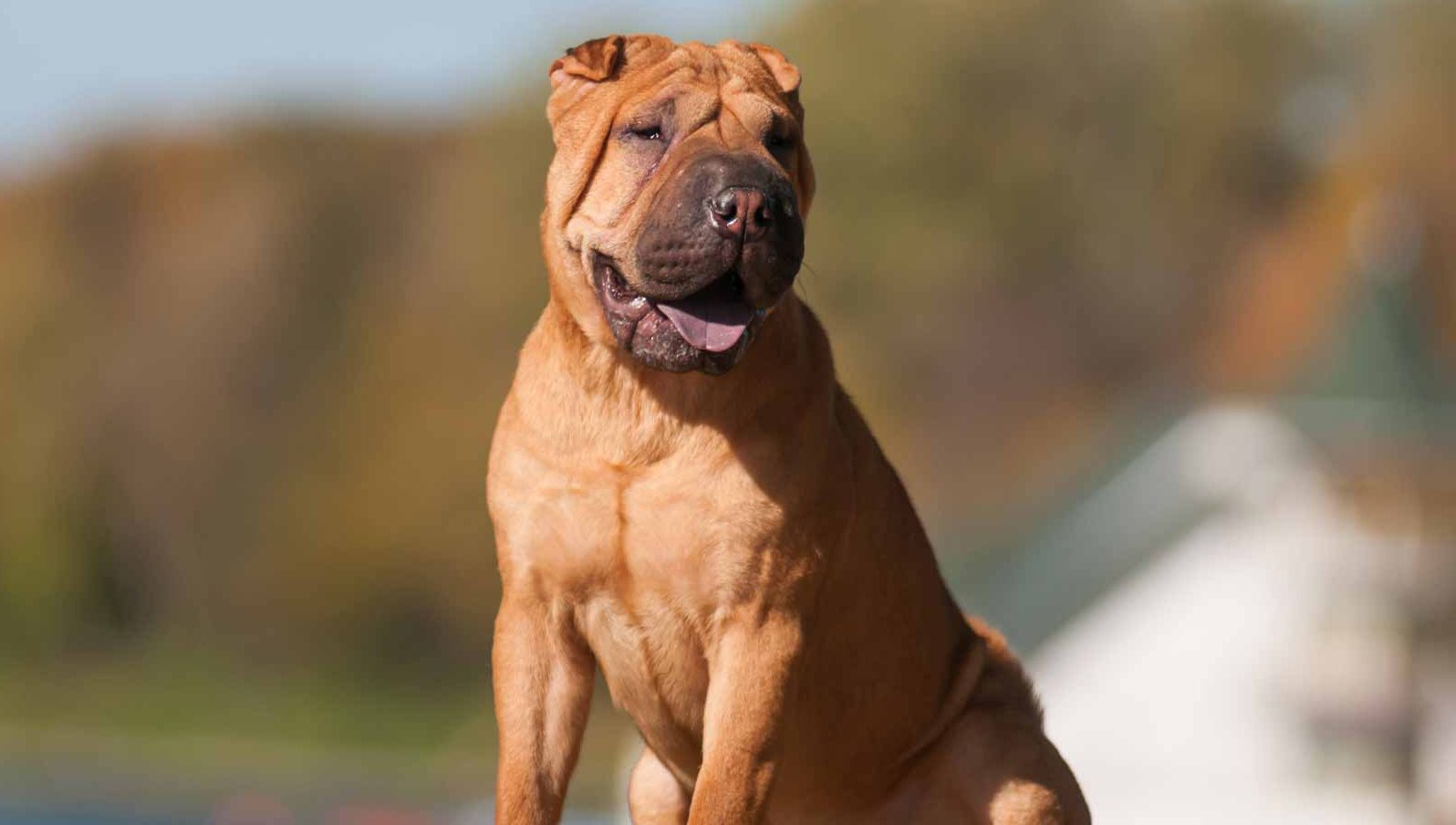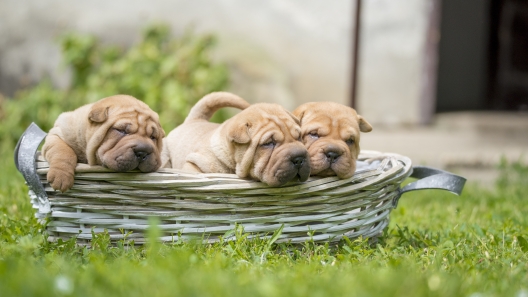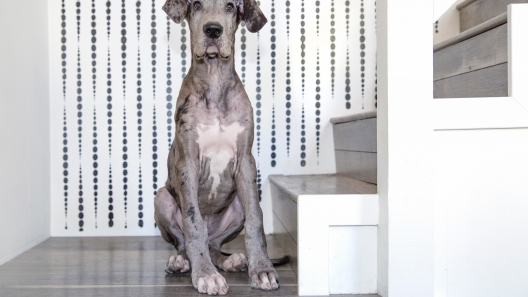-
Activity Level:
moderate
-
Shedding Level:
moderate
-
Grooming Level:
low
-
Trainability:
high
-
Good for Novice Owners:
moderate
-
Adaptability:
high
-
Kid/Pet Friendly:
sometimes
-
Prey Drive:
low
-
Watchdog:
very alert
- Average Size: Medium
- Average Lifespan: 8-12 years
- Registered?: aca, akc
Shar Pei Dog Breed Information
Overview
Temperament
Adaptability
Health
Owner Experience
Grooming
Activity Level
Size
Life Span
Did You Know?
The Shar-Pei is an ancient dog breed that originated in China and dates back to the Han Dynasty over 2,000 years ago. They were native to China’s southern provinces. Unlike the Pug, they were not known as a noble companion. Instead, one of the facts about the Shar-Pei is that they were considered a commoner’s dog.
In particular, they were primarily used by Chinese farmers as all-around farm dogs. These wrinkly, unique dogs were prized for their intelligence, rugged versatility, and fierce loyalty. Shar-Pei could often be found working simultaneously as herders and protectors on the farm, as hunting dogs, and as family companions.
In 1949, the People’s Republic of China was established. Because dog ownership was frowned upon under this regime, many dogs were systematically slaughtered. As a result, many of the mainland’s purebred dogs were almost wiped out of existence. Thankfully, a few good Shar-Pei breeding pairs were preserved in Taiwan and Hong Kong. And so, the breed was able to survive and then thrive.
Although the first documented appearance of the Shar-Pei in the United States occurred in the mid-1960s, they did not start to gain popularity until 1973. This was the year that Matgo Law, a breeder in Hong Kong, appealed to breeders and dog fans in the United States to help save the Shar-Pei from extinction.
Dog lovers in the U.S. fell in love with the Shar-Pei’s unique looks, and the story pulled at their heartstrings. From there, the Shar-Pei truly made it to the United States, and the population began to increase. This outreach and ensuing intervention are credited for ensuring the breed’s survival. The American Kennel Club recognized the Chinese Shar-Pei as a member of the Non-Sporting Group in 1992.
The Chinese Shar-Pei is a dog that is devoted and fiercely loyal to their families. They may have an independent nature and are considered one of the most independent dog breeds, but they do bond closely with their families and are affectionate with them. Well-socialized, they tend to have a calm and gentle demeanor at home and also tend to do well with older children and other dogs in the family.
Due to their guardian instincts, they can be wary and standoffish with strangers. Socialization and training early and often are important for any dog breed. But, as a breed with a protective instinct, they are particularly important for the Shar-Pei. A poorly socialized or poorly trained Shar-Pei can become territorial and their natural suspicion towards strangers can turn into aggression if they perceive them as a threat.
The Shar-Pei is a highly adaptable dog breed. They thrive in large homes with fenced-in yards where they can patrol, play, and run. But, they are also one of the best large dog breeds for small homes. They can adapt well to smaller homes and apartments as long as they get the mental stimulation, affection, and exercise they need to be happy and healthy.
Chinese Shar-Pei do well in moderate climates. However, as a short-snouted dog, they do not handle heat well. They also may need to bundle up when the temperatures drop to stay warm. Keeping a close eye on them in the summer and having the right winter dog products on hand when it’s cold can be a big help in keeping your Shar-Pei comfortable and safe throughout the seasons.
Although this dog breed is independent and can handle some alone time, you don’t want to leave them alone for too long. They do bond closely with their families and prefer to be near them. Plus, they can get bored easily, and bored dogs can easily become destructive dogs.
For the Shar-Pei, potential health concerns can include eye disorders like glaucoma, retinal dysplasia, entropion, and SARDS. Hip and elbow dysplasia, cardiovascular issues, thyroid conditions, skin issues, and gastrointestinal disorders have all been found in the breed. Good breeding practices and the health of the parents make a big difference in the health of Shar Pei puppies.
Reputable breeders will screen their dogs to avoid passing on issues to puppies as much as possible. So, don’t be afraid to ask them about the health and genetic history of both parents. You can also ask about any relevant health clearances or test results to further allay any concerns you may have. The Chinese Shar-Pei Club of America, Inc. recommends an elbow evaluation, a hip evaluation, an ophthalmologist evaluation, and a patella evaluation.
As a larger, broad-chested dog breed, the Shar-Pei is also at a higher risk of bloat, which can become very serious, very quickly if gastric torsion occurs (i.e., if the stomach flips). It’s important to know what you can do to prevent it, as well as the signs of bloat in dogs, so you know when it’s time to get to the vet immediately.
Although the Shar-Pei is highly intelligent and picks up on things quickly, they also have an independent nature and can be quite stubborn. This can be difficult for a first-time dog owner to handle on their own.
As such, puppy training classes or enlisting the help of a professional dog trainer is recommended for novice owners. Regardless of owner experience, puppy training classes can still be a good idea as they often offer opportunities to socialize a puppy on top of providing some structure and consistency for training.
The Shar-Pei will shed regularly throughout the year and will probably drool too. Weekly brushing and the occasional bath, as needed, are usually enough to keep this dog’s coat looking great. You will also need to regularly clean and wipe between your Shar-Pei’s infamous wrinkles to make sure they are clean and dry to help prevent skin irritation.
In addition to coat and wrinkle care, you will also need to care for your Shar-Pei’s nails, ears, and teeth. Once or twice monthly nail trimming is usually enough to keep nails from growing too long. But, if nails are clicking on the floor, it’s time to cut your dog’s nails. They may just grow quickly, or your dog might not be wearing them down as much naturally.
Checking ears weekly and carefully cleaning your dog’s ears as needed can help prevent ear infections. You want to make sure ears are clean, dry, and free of debris and pests. If you see irritation, redness, excess wax or moisture, or something else that looks concerning, then you know it’s time to get to the vet before it gets worse.
It’s also important to take care of your dog’s teeth. Unfortunately, many dog owners overlook this, which is why gum disease is one of the most common health issues in dogs. By practicing good dental care for dogs, you can help prevent painful dental diseases later in life.
Ideally, you’re brushing your dog’s teeth or using an enzyme toothpaste every day in addition to getting cleanings done at the vet when needed. You can also talk to your vet about good dental hygiene chews and even work with them to create a “dental care diet” customized to your pup.
Overall, the Shar-Pei has a moderate activity level. However, this will vary among individual dogs. You should be prepared for daily walks plus some playtime and extra activity. Oftentimes, a Shar-Pei will be up for more activity if you are. So, don’t be afraid to try some different activities with them.
You may find that your Shar-Pei loves going on hikes, playing frisbee, or even training for dog sports. Because of their versatility, they tend to be a good fit for a variety of dog sports like agility, obedience, rally, tracking, and more. Just make sure to keep things low-impact until puppies are finished growing to avoid damaging developing bones and joints.
Fully-grown Shar-Pei usually stand 18-20 inches tall and weigh 45-60 pounds.
A Shar-Pei generally lives for 8-12 years on average.
There are ancient Chinese statues that resemble the Shar-Pei and Chinese manuscripts dating back to ancient times that reference “wrinkled dogs”. Also, the Shar-Pei tends to have a dark tongue like the Chow Chow.








